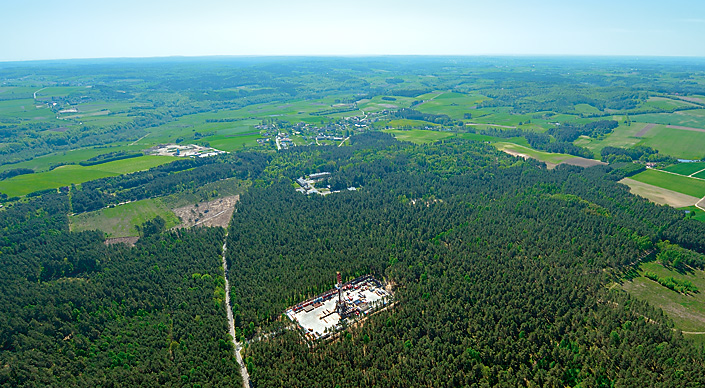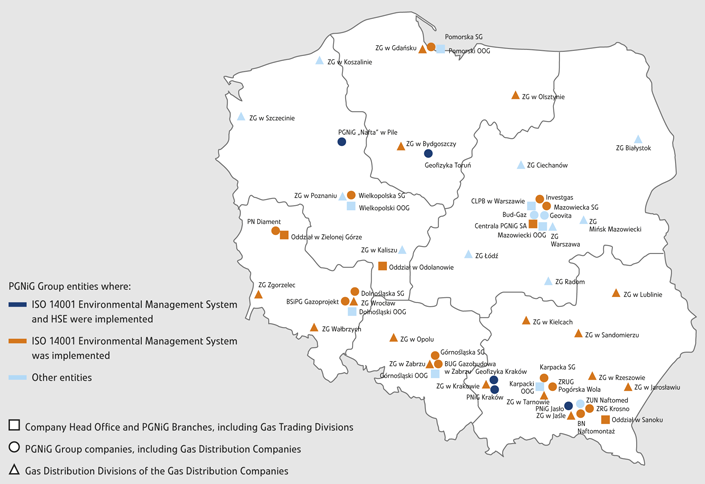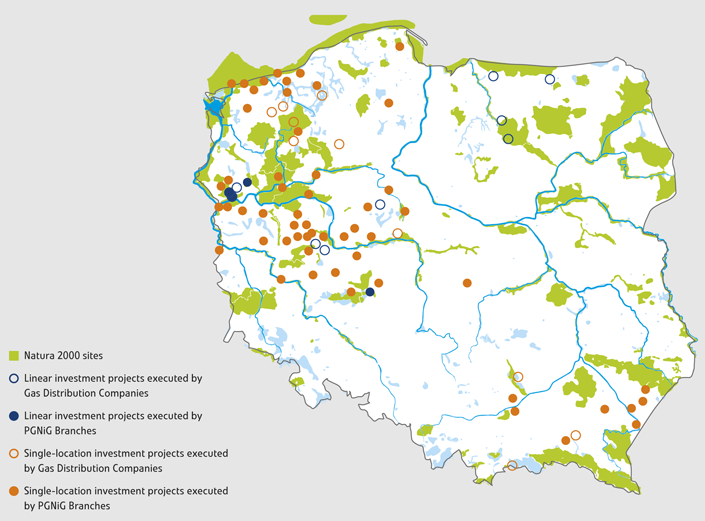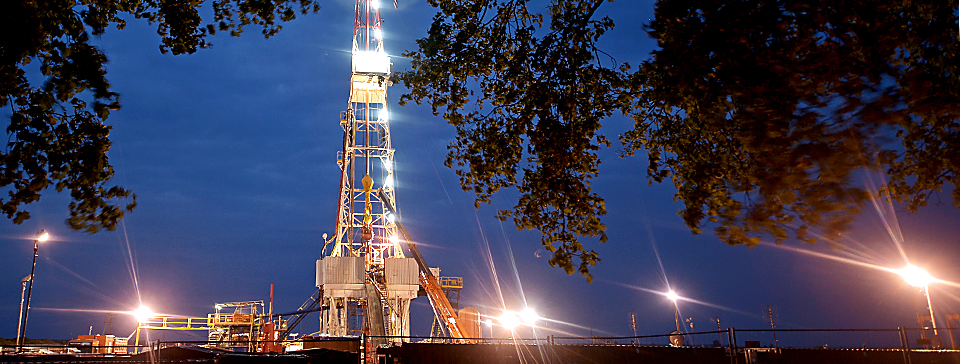Environmental protection
The PGNiG Group always seeks to make efficient use of resources, raw materials and energy. Apart from investing in technologies designed to reduce emissions of harmful gases and waste, we also reclaim land previously used for oil and gas projects.
Environmental impact
The PGNiG Group’s operations affect the balance of the environment. Both the production of natural gas and crude oil and their distribution interfere with the environment. On the other hand, the use of natural gas helps reduce atmospheric emissions more than other fossil fuels.
All companies of the PGNiG Group seek to minimize the negative impacts of their operations. To that end, they follow the applicable Polish and EU laws, as well as internal standards and regulations. Thanks to the implementation and certification of environmental management systems at most of the PGNiG branches and Group companies, a number of notable environmental benefits have been achieved. Our efforts are, in the first place, geared to limiting our negative environmental impact and monitoring processes on an ongoing basis. These rules are followed by the Group companies not only in their operations in Poland, but also in their exploration work abroad. Environment-oriented projects accompany all operations of the PGNiG Group – from hydrocarbon production to distribution and storage.
Following the provisions of the Environmental Protection Act, the PGNiG Group companies conduct evaluation and land reclamation work in the areas contaminated in the course of its past operations (e.g. traditional gas industry) with a view to restoring them to the condition prescribed by the environmental quality standards.
In addition, PGNiG strives to educate its employees in the area of environmental protection. The Company organises training courses and conferences at which key issues related to environmental protection are discussed. They are also aimed at defining a common range of tasks to be implemented in the future, primarily those relating to the goals of the CSR Strategy for the Group.
Well abandonment
Pursuant to the Polish Geological and Mining Law, PGNiG is required to properly abandon worked-out mining pits, eliminate the danger and repair any damage caused by mineral extraction, and restore the land to its original condition. Plugging of wells and pits prevents leakage of crude oil and natural gas to the surface and to water courses. Furthermore, if gas wells remain unplugged, there is a risk that escaping gas could accumulate, posing a fire hazard. In 2012, a total of fifteen wells and five mining pits were abandoned.

Land reclamation and non-productive asset surveying
Pursuant to the Environmental Protection Law, PGNiG conducts appraisals and land reclamation work in areas which have become polluted in the course of its earlier operations (including those related to traditional gas production), with a view to restoring them to the condition prescribed by environmental quality standards.
In 2012, two tender procedures were prepared and carried out to select a contractor to reclaim derelict land on the properties located in the villages of Kargów (at ul. Browarna) and Radków (at ul. Leśna). The work is to commence in the first half of 2013. Also in 2013, reclamation work is planned on the property located in Łabiszyn, at ul. Szubińska 17 (approval of the Funds Controller) and in Sobótka, at ul. Czysta 1.
In H2 2012, tests and surveys were undertaken in the area surrounding an abandoned well and an old waste pit discovered in the former operating area of the Zielona Góra Branch in Międzyzdroje. In the same period, the Company undertook a monitoring exercise to assess the environmental impact of the reclaimed landfill site in Zabrze-Biskupice, as well as a monitoring exercise on a property located in Zabrze, at ul. Pawliczka.
Carbon credit trading system
In 2012, CO2 emissions from our facilities covered by the CO2 emissions trading scheme (EU ETS) reached 85,655 Mg. In the above trading period, installations participating in the scheme were those of the Odolanów and Zielona Góra Branches, as well as the Mogilno Underground Gas Storage Cavern Facility.
A review of the annual CO2 emissions reports for 2012 and matching of the actual CO2 emissions with credits held were slated for early March 2013.
CO2 emissions [Mg] in 2012
| facility name | National Allocation Plan No. | emission allowances [Mg] |
actual emissions in 2012 [Mg] |
remaining amount [Mg] |
|---|---|---|---|---|
| Mogilno Underground Gas Storage Cavern Facility | PL- 898-08 | 26,642 | 10,311 | 16,331 |
| PGNiG Odolanów Branch | PL-562-05 | 11,181 | 12,678 | (1,497) |
| PGNiG Odolanów Branch | PL-950-08 | 30,495 | 31,856 | (1,361) |
| PGNiG Zielona Góra Branch, Dębno Oil and Gas Production Facility | PL-563-05 | 31,664 | 30,810 | 854 |
| Total | 99,982 | 85,655 | 14,327 |
Recording of methane emissions from the gas distribution network
Detailed recording of methane emissions from the gas distribution system was continued in 2012. In line with the schedule of work under the contract with Instytut Nafty i Gazu (Oil and Gas Institute) of Kraków (the contractor), the second stage of the project, involving a review of the emission indicators through field measurements taken in the area covered by the distribution network, was completed.
The purpose of the exercise is to estimate the volume of methane emissions from particular components of the system, review the emission indicators applied to date, and develop uniform indicators and calculation methods for methane emissions. Standardised and reliable methane emission indicators will help reduce the cost of environmental fees and charges.
Chemical mixtures and substances in the light of EU requirements
In 2012, the Environmental Protection Division prepared Material Safety Data Sheets for substances produced by PGNiG, in compliance with the regulations of the European Parliament and the Council of the European Union on safe use of chemicals (REACH) and on the classification, labelling and packaging of substances and mixtures (CLP):
- for natural gas (high pressure, low pressure);
- for crude oil (variable composition, including crude containing sulphur);
- for hydrocarbon condensate;
- for LPG;
- for LNG;
- for He (compressed and liquid);
- for N (compressed and liquid).
Classifications of the substances listed above have been submitted to the ECHA (European Chemicals Agency) via its electronic platform. The Material Safety Data Sheets have been delivered to the PGNiG Branches.
Support of ongoing and planned projects
Once the Geology and Hydrocarbon Production Branch was established and the environmental protection functions of the Zielona Góra and Sanok Branches were partly transferred to the Environmental Protection Division (EPD), which is tasked with the role of supporting the ongoing and planned investment projects – is engaged in the procedure of issuing administrative decisions. For instance, in 2012 the Environmental Protection Division supervised and coordinated the performance of environmental stock-taking exercises and the preparation of waste management schemes, while participating in the consultations on choosing the locations and submitting derogation requests for a total of 20 wells.
Environmental Management System
In May 2012, Det Norske Veritas – acting under the management system certification agreement – performed a recertification audit to confirm the effectiveness of the environmental management system in place at the PGNiG Head Office and its compliance with the PN-EN ISO 14001:2005 standard. The auditors focused on the supervision of operating activities related to the Company’s environmental performance. According to the audit report, the system was found to fully conform with the criteria of the PN-EN ISO 14001:2005 standard. Based on the favourable audit results and positive assessment, the certificate confirming compliance of the Environmental Management System with the PN-EN ISO 14001:2005 standard was extended until 2015.
To date, as many as three-quarters of the PGNiG Branches and PGNiG Group companies have implemented, certificated and maintain the Environmental Management System (EMS), which is frequently integrated with other systems, such as quality, OHS or information security management. In March 2012, a certification audit at Mazowiecka Spółka Gazownictwa was completed. The company received a certificate confirming compliance of its Environmental Management System with the PN-EN ISO 14001:2005 standard.
Environmental Management Systems in the PGNiG Group

Nature 2000
When selecting a site for a project, we take into consideration the presence of any protected areas, Natura 2000 sites or other areas of high environmental value, which – on one hand – require special procedures during the execution phase or compensatory measures, and – on the other hand – may constrain our plans. When undertaking investment projects which require an environmental impact assessment, PGNiG Group companies observe all relevant procedures and prepare environmental reports. Our advanced technological solutions enable us to limit our impact on flora and fauna by reducing the size of tree-felling areas, securing tree root systems during earthworks, and limiting vibrations as well as noise and pollutant emissions, particularly during the mating and breeding seasons.
Investment projects of the PGNiG Group in protected areas







